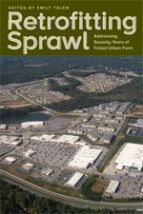Retrofitting Sprawl: Addressing Seventy Years of Failed Urban Form

Publisher:
University of Georgia Press
Pages:
263
Year:
2015
Retrofitting Sprawl: Addressing Seventy Years of Failed Urban Form is edited by Emily Talen and grew out of the Retrofitting Sprawl symposium hosted by Arizona State University in April 2012. In this book Talen presents 12 previously unpublished essays written by authors in a range of fields. The objective is to offer a consolidated overview of current thinking and practice about ways to fix, repair or “retrofit” sprawl.
Divided into three sections, this book looks at “Existing Realities”, “Case Studies” and “Imagined Possibilities” for US cities and suburbs. Each section is made up of four individual chapters written by different authors. The first section “uncovers some essential baseline realities about the prospects for retrofitting sprawl” (page 2). Chapter 1 details research using a dataset called Walk Scores and reveals how omnipresent and visible sprawl is in the US. The difficulties of fixing sprawl from a structural perspective are then explored in Chapter 2. Chapter offers 3 three lessons from a case study of zoning reform in Montgomery County, Maryland. Chapter 4 then draws upon interviews with 101 residents of Phoenix, Arizona to look at the reasons that – despite its negative impacts – so many people choose to live in sprawl.
Through a series of case studies, Section Two presents “real world examples of how sprawl is actually being transformed” (page 4). It begins with Chapter 5, which details 11 urban design tactics that have either been implemented or are being proposed in support of three major urban design strategies (reinhabitation, redevelopment and regreening) to retrofit sprawl. In particular the chapter draws upon innovations suggested for the 2010 Build a Better Burb competition for New York’s Long Island (page 103). Chapter 6 considers the redevelopment of suburban downtowns through three case studies, all illustrating that strong community engagement is important to make these redevelopments successful (page 123). Chapter 7 discusses the redevelopment of Walker’s Bend, a failed subdivision in Covington, Georgia; there “creative partnerships were key to the successful integration of affordable housing” (page 139). Chapter 8 ends this section with a focus on the importance of increasing walkability when retrofitting sprawl (page 158). Here documentation of pedestrian networks around six commercial strips in Oregon and Georgia is reviewed (page 160).
Section Three moves on to innovative ideas. Chapter 9 rethinks on-street parking and considers creative uses for “underutilized suburban residential parking strips” (page 181). Chapter 10 then explores how marginalized communities in sprawl-affected locations can in fact perform types of retrofit tactics through their use of ill-defined spaces (page 199). The potential that cul-de-sacs offer for retrofitting sprawl is explored in Chapter 11 and illustrated using a design intervention for a subdivision in Avondale, Arizona (page 224). The final chapter continues looking at the potential of retrofitting cul-de-sacs in sprawl areas. In particular it offers three strategies to achieve this (page 241).
Book note prepared by Hannah Keren Lee
Divided into three sections, this book looks at “Existing Realities”, “Case Studies” and “Imagined Possibilities” for US cities and suburbs. Each section is made up of four individual chapters written by different authors. The first section “uncovers some essential baseline realities about the prospects for retrofitting sprawl” (page 2). Chapter 1 details research using a dataset called Walk Scores and reveals how omnipresent and visible sprawl is in the US. The difficulties of fixing sprawl from a structural perspective are then explored in Chapter 2. Chapter offers 3 three lessons from a case study of zoning reform in Montgomery County, Maryland. Chapter 4 then draws upon interviews with 101 residents of Phoenix, Arizona to look at the reasons that – despite its negative impacts – so many people choose to live in sprawl.
Through a series of case studies, Section Two presents “real world examples of how sprawl is actually being transformed” (page 4). It begins with Chapter 5, which details 11 urban design tactics that have either been implemented or are being proposed in support of three major urban design strategies (reinhabitation, redevelopment and regreening) to retrofit sprawl. In particular the chapter draws upon innovations suggested for the 2010 Build a Better Burb competition for New York’s Long Island (page 103). Chapter 6 considers the redevelopment of suburban downtowns through three case studies, all illustrating that strong community engagement is important to make these redevelopments successful (page 123). Chapter 7 discusses the redevelopment of Walker’s Bend, a failed subdivision in Covington, Georgia; there “creative partnerships were key to the successful integration of affordable housing” (page 139). Chapter 8 ends this section with a focus on the importance of increasing walkability when retrofitting sprawl (page 158). Here documentation of pedestrian networks around six commercial strips in Oregon and Georgia is reviewed (page 160).
Section Three moves on to innovative ideas. Chapter 9 rethinks on-street parking and considers creative uses for “underutilized suburban residential parking strips” (page 181). Chapter 10 then explores how marginalized communities in sprawl-affected locations can in fact perform types of retrofit tactics through their use of ill-defined spaces (page 199). The potential that cul-de-sacs offer for retrofitting sprawl is explored in Chapter 11 and illustrated using a design intervention for a subdivision in Avondale, Arizona (page 224). The final chapter continues looking at the potential of retrofitting cul-de-sacs in sprawl areas. In particular it offers three strategies to achieve this (page 241).
Book note prepared by Hannah Keren Lee
Search the Book notes database
Our Book notes database contains details and summaries of all the publications included in Book notes since 1993 - with details on how to obtain/download.
Use the search form above, or visit the Book notes landing page for more options and latest content.
For a searchable database for papers in Environment and Urbanization, go to http://eau.sagepub.com/

